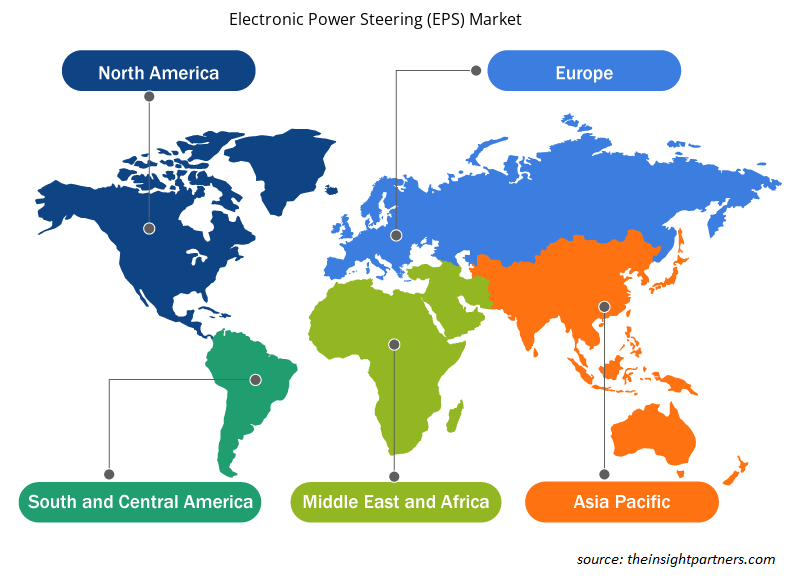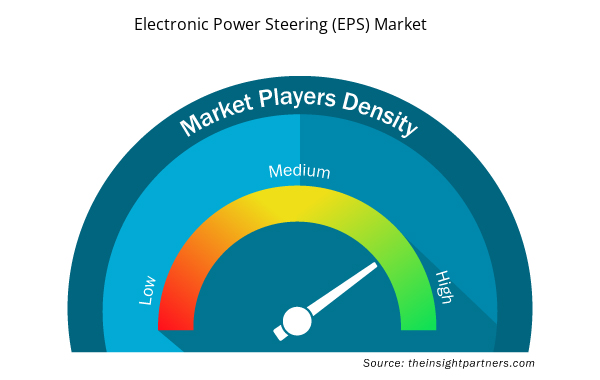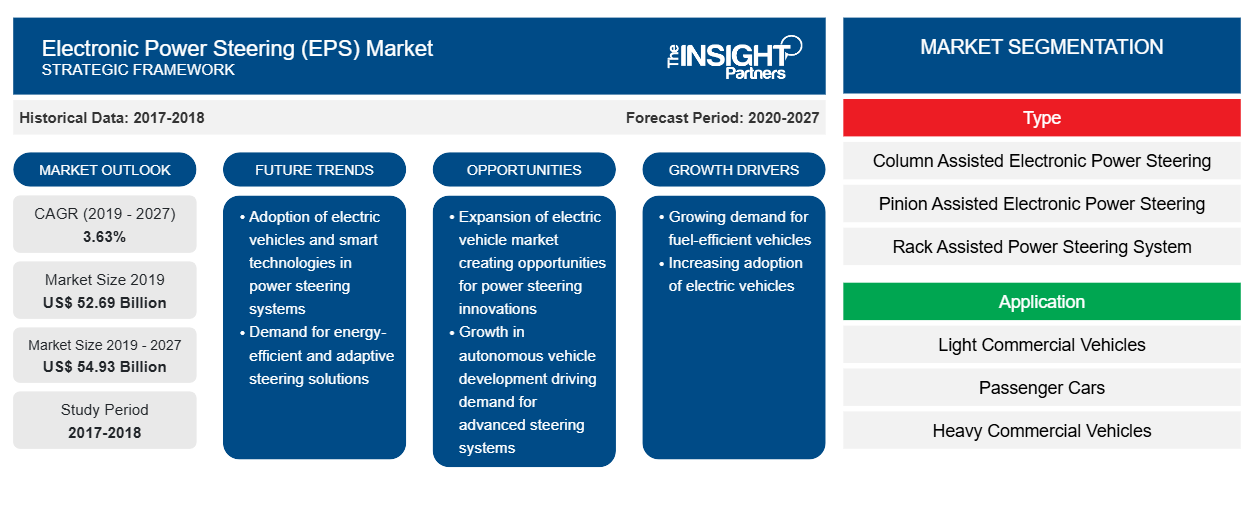بلغت قيمة سوق التوجيه الإلكتروني العالمي 52،692.31 مليون دولار أمريكي في عام 2019، ومن المتوقع أن ينمو بمعدل نمو سنوي مركب قدره 3.63٪ خلال الفترة المتوقعة من 2020 إلى 2027.
تم تقسيم سوق التوجيه الإلكتروني المعزز على نطاق واسع إلى خمس مناطق رئيسية - أمريكا الشمالية وأوروبا ومنطقة آسيا والمحيط الهادئ والشرق الأوسط وأفريقيا وجنوب شرق آسيا. كانت منطقة آسيا والمحيط الهادئ تهيمن على السوق العالمية في عام 2019، والتي شكلت ما يقرب من نصف السوق الإجمالية بسبب الطلب المتزايد على أنظمة التوجيه الإلكتروني المعزز. تساهم عوامل مثل التبني الأكثر شمولاً للسيارات الفاخرة والسيارات السيدان وسيارات الدفع الرباعي بين سكان منطقة آسيا والمحيط الهادئ بشكل كبير في حصة السوق الأكثر أهمية في المنطقة. علاوة على ذلك، تعد شركة فورد موتور الأسترالية المحدودة، وشركة تويوتا موتور كوربوريشن أستراليا المحدودة، وشركة ميتسوبيشي موتورز أستراليا المحدودة (MMAL)، وشركة جنرال موتورز هولدن، وإيسوزو أستراليا المحدودة، ومجموعة فولكس فاجن أستراليا المحدودة، وهيونداي كوميرشال فيكلز أستراليا من بين الشركات المصنعة المعروفة للمركبات التجارية في البلاد. تطالب كل هذه الشركات المصنعة بدمج نظام التوجيه الإلكتروني المعزز في السيارات لتلبية الطلب الناشئ من العملاء. علاوة على ذلك، من المتوقع أن تؤدي عمليات تصنيع السيارات المتصاعدة، والطلب المتزايد على المركبات الكهربائية، والتركيز المتزايد من جانب مصنعي EPS نحو تقديم منتجات منخفضة التكلفة وعالية الكفاءة إلى دفع نمو سوق EPS في بقية دول منطقة آسيا والمحيط الهادئ خلال الفترة المتوقعة.
رؤى السوق - سوق نظام التوجيه المعزز إلكترونيًا
نمو مبيعات السيارات الفاخرة في الصين
قم بتخصيص هذا التقرير ليناسب متطلباتك
ستحصل على تخصيص لأي تقرير - مجانًا - بما في ذلك أجزاء من هذا التقرير، أو تحليل على مستوى الدولة، وحزمة بيانات Excel، بالإضافة إلى الاستفادة من العروض والخصومات الرائعة للشركات الناشئة والجامعات
- احصل على أهم اتجاهات السوق الرئيسية لهذا التقرير.ستتضمن هذه العينة المجانية تحليلاً للبيانات، بدءًا من اتجاهات السوق وحتى التقديرات والتوقعات.
في عام 2019، استحوذت الصين على ما يقرب من 21.4 مليون مركبة. تعد البلاد أكبر منتج وكذلك أكبر سوق لمبيعات السيارات على مستوى العالم. ومع ذلك، في عام 2019، انخفضت مبيعات السيارات الإجمالية بنحو 1.9٪، لكن الطلب على سيارات الدفع الرباعي والسيارات السيدان الفاخرة زاد بمعدل 3.5٪ و 18.8٪ على التوالي مقارنة بعام 2018. أبلغت جميع شركات تصنيع السيارات الفاخرة الكبرى في البلاد، بما في ذلك بي إم دبليو ومرسيدس بنز وأودي، عن أرقام إيجابية في نوفمبر 2019. جنبًا إلى جنب مع ارتفاع المبيعات، تغير سيناريو السوق أيضًا بسرعة. في الجيل السابق، اعتاد المستهلكون على شراء المركبات الفاخرة في الغالب للكشف عن مكانتهم الاجتماعية، لكن الجيل الجديد المتطور تدريجيًا من المشترين يشتري السيارات الفاخرة لمتطلبات التكنولوجيا الفاخرة والذكية. وفقًا لدراسة أجرتها جمعية مصنعي السيارات الصينية، تلعب النساء دورًا مهمًا في سوق السيارات الفاخرة الصينية. وذكر هذا الاستطلاع أنه عند اختيار طراز السيارة، فإن النساء يقدرن ميزات السلامة والراحة والتصميم الخارجي، على الصفات التي يفضلها نظراؤهن من الرجال، مثل تكنولوجيا نقل الحركة، والعلامات التجارية الفاخرة المعترف بها اجتماعيًا، والطرازات الأكبر حجمًا. ومن شأن العوامل المذكورة أعلاه أن تدفع الطلب على دمج EPS في سيارات السيدان وسيارات الدفع الرباعي.
تأثير كوفيد-19
تعد صناعة أشباه الموصلات والسيارات من بين ضحايا كوفيد-19، ومنذ بداية عام 2020، كانت هذه الصناعات تعكس اتجاهًا تنازليًا. مع فرض الإغلاق في جميع أنحاء البلدان في أمريكا الشمالية وأوروبا وآسيا، شهدت الصناعات تجربة مدمرة. تتطلب صناعة السيارات عددًا كبيرًا من العمالة البشرية، وعلى العكس من ذلك، ينتشر فيروس كوفيد-19 من خلال التدخل البشري، ولا يستطيع القطاع العمل بشكل صحيح. يعكس الاتجاه التنازلي في صناعة السيارات وأشباه الموصلات تأثيرًا سلبيًا على سوق التوجيه المعزز الإلكتروني.
رؤى حول نوع الشريحة
بناءً على النوع، هيمن قطاع التوجيه الإلكتروني المعزز بالعمود على سوق التوجيه الإلكتروني المعزز العالمي في عام 2019. يحل نظام التوجيه الإلكتروني المعزز تدريجيًا محل نظام التوجيه التقليدي في المركبات الحديثة. تتمثل الفائدة الرئيسية لاستخدام نظام التوجيه الإلكتروني المعزز في القدرة على تقليل استهلاك الطاقة. يعد نظام التوجيه الإلكتروني المعزز بالعمود (C-EPS) أحد أنواع نظام التوجيه الإلكتروني المعزز.
رؤى حول فئات أنواع المركبات
استنادًا إلى نوع السيارة، احتل قطاع سيارات الركاب أكبر حصة في سوق التوجيه الإلكتروني العالمي في عام 2019. سيارات الركاب هي مركبات النقل التي لا يزيد عدد مقاعدها عن ثمانية مقاعد. نظرًا لتدهور الطقس وجودة الهواء في دول مثل بنجلاديش وباكستان ومنغوليا وأفغانستان والهند، يتبنى الناس الوقود البديل والتقنيات ذات الصلة في سيارات الركاب الخاصة بهم. يمكن تقسيم سيارات الركاب إلى سيارات سيدان وهاتشباك وSUV أو MUV. يتزايد الطلب على سيارات الركاب مع ارتفاع دخل الفرد والحاجة إلى الرفاهية.
يركز اللاعبون في السوق على ابتكارات وتطويرات المنتجات الجديدة من خلال دمج التقنيات والميزات المتقدمة في منتجاتهم للتنافس مع المنافسين.
- في عام 2019، أعلنت شركة Nexteer Automotive عن إنجازها المتمثل في إنتاج 60 مليون نظام توجيه كهربائي (EPS) على مستوى العالم. ويمكن استخدام هذا النظام في المركبات التي تتراوح من السيارات الصغيرة إلى الشاحنات الكبيرة. تعمل أنظمة التوجيه الكهربائي على زيادة كفاءة استهلاك الوقود بنسبة 6% وانبعاثات ثاني أكسيد الكربون بمقدار 8 جرام لكل كيلومتر.
- في عام 2018، قامت شركة Robert Bosch GmbH بتثبيت أنظمة Bosch للمساعدة على القيادة الآلية جزئيًا، والتي تم تركيبها على جميع المركبات في مجموعة Maserati MY 2018. إلى جانب ذلك، يساهم نظام التوجيه الكهربائي (EPS) من Bosch، وهو ابتكار آخر تم تقديمه في مجموعة Maserati MY2018، في تنفيذ تقنية المساعدة على القيادة على الطرق السريعة وأنظمة مساعدة القيادة المتقدمة الأخرى.
- في عام 2018، طورت شركة هيونداي موبيس نظام توجيه كهربائي يستفيد من دائرتين إلكترونيتين أثناء القيادة الذاتية من أجل الحفاظ على قدرات التوجيه الطبيعية تحت أي ظرف من الظروف.
نظام التوجيه الإلكتروني
رؤى إقليمية حول سوق نظام التوجيه الإلكتروني المعزز (EPS)
لقد قام المحللون في Insight Partners بشرح الاتجاهات والعوامل الإقليمية المؤثرة على سوق التوجيه الإلكتروني (EPS) طوال فترة التوقعات بشكل شامل. يناقش هذا القسم أيضًا قطاعات سوق التوجيه الإلكتروني (EPS) والجغرافيا في جميع أنحاء أمريكا الشمالية وأوروبا ومنطقة آسيا والمحيط الهادئ والشرق الأوسط وأفريقيا وأمريكا الجنوبية والوسطى.

- احصل على البيانات الإقليمية المحددة لسوق التوجيه الإلكتروني المعزز (EPS)
نطاق تقرير سوق نظام التوجيه الإلكتروني المعزز (EPS)
| سمة التقرير | تفاصيل |
|---|---|
| حجم السوق في عام 2019 | 52.69 مليار دولار أمريكي |
| حجم السوق بحلول عام 2027 | 54.93 مليار دولار أمريكي |
| معدل النمو السنوي المركب العالمي (2019 - 2027) | 3.63% |
| البيانات التاريخية | 2017-2018 |
| فترة التنبؤ | 2020-2027 |
| القطاعات المغطاة | حسب النوع
|
| المناطق والدول المغطاة | أمريكا الشمالية
|
| قادة السوق وملفات تعريف الشركات الرئيسية |
|
كثافة اللاعبين في سوق نظام التوجيه المعزز إلكترونيًا (EPS): فهم تأثيره على ديناميكيات الأعمال
يشهد سوق التوجيه الإلكتروني (EPS) نموًا سريعًا، مدفوعًا بالطلب المتزايد من المستخدم النهائي بسبب عوامل مثل تفضيلات المستهلك المتطورة والتقدم التكنولوجي والوعي المتزايد بفوائد المنتج. ومع ارتفاع الطلب، تعمل الشركات على توسيع عروضها والابتكار لتلبية احتياجات المستهلكين والاستفادة من الاتجاهات الناشئة، مما يؤدي إلى زيادة نمو السوق.
تشير كثافة اللاعبين في السوق إلى توزيع الشركات أو المؤسسات العاملة في سوق أو صناعة معينة. وهي تشير إلى عدد المنافسين (اللاعبين في السوق) الموجودين في مساحة سوق معينة نسبة إلى حجمها أو قيمتها السوقية الإجمالية.
الشركات الرئيسية العاملة في سوق نظام التوجيه الإلكتروني (EPS) هي:
- هيونداي موبيس
- شركة جيه تيكت
- شركة ميتسوبيشي الكتريك
- نيكستير للسيارات
- شركة إن إس كيه المحدودة
إخلاء المسؤولية : الشركات المذكورة أعلاه ليست مرتبة بأي ترتيب معين.

- احصل على نظرة عامة على أهم اللاعبين الرئيسيين في سوق التوجيه الإلكتروني (EPS)
تم تقسيم سوق التوجيه الإلكتروني العالمي على النحو التالي:
سوق التوجيه المعزز إلكترونيًا – حسب النوع
- نظام التوجيه الإلكتروني بمساعدة العمود
- نظام التوجيه الإلكتروني بمساعدة الترس
- نظام التوجيه المعزز بمساعدة الرف
- نظام التوجيه الهيدروليكي الإلكتروني
سوق التوجيه المعزز إلكترونيًا – حسب نوع السيارة
- المركبات التجارية الخفيفة
- سيارات الركاب
- المركبات التجارية الثقيلة
سوق التوجيه الإلكتروني حسب المنطقة
أمريكا الشمالية
- نحن
- كندا
- المكسيك
أوروبا
- فرنسا
- ألمانيا
- إيطاليا
- المملكة المتحدة
- روسيا
- بقية أوروبا
آسيا والمحيط الهادئ (APAC)
- الصين
- الهند
- كوريا الجنوبية
- اليابان
- أستراليا
- بقية منطقة آسيا والمحيط الهادئ
الشرق الأوسط وأفريقيا
- جنوب أفريقيا
- المملكة العربية السعودية
- الامارات العربية المتحدة
- باقي منطقة الشرق الأوسط وأفريقيا
أمريكا الجنوبية (SAM)
- البرازيل
- الأرجنتين
- بقية سام
سوق التوجيه المعزز إلكترونيًا – ملفات تعريف الشركات
- هيونداي موبيس
- شركة جيه تيكت
- شركة ميتسوبيشي الكتريك
- نيكستير للسيارات
- شركة إن إس كيه المحدودة
- شركة روبرت بوش المحدودة
- شركة شووا
- شركة ماندو
- شركة تيسنكروب
- شركة ZF فريدريشهافن ايه جي
- التحليل التاريخي (سنتان)، السنة الأساسية، التوقعات (7 سنوات) مع معدل النمو السنوي المركب
- تحليل PEST و SWOT
- حجم السوق والقيمة / الحجم - عالميًا وإقليميًا وقطريًا
- الصناعة والمنافسة
- مجموعة بيانات Excel


- Nuclear Decommissioning Services Market
- Asset Integrity Management Market
- Cut Flowers Market
- Employment Screening Services Market
- Bioremediation Technology and Services Market
- Trade Promotion Management Software Market
- Helicopters Market
- Dry Eye Products Market
- Resistance Bands Market
- Hair Wig Market

Report Coverage
Revenue forecast, Company Analysis, Industry landscape, Growth factors, and Trends

Segment Covered
This text is related
to segments covered.

Regional Scope
North America, Europe, Asia Pacific, Middle East & Africa, South & Central America

Country Scope
This text is related
to country scope.
الأسئلة الشائعة
The electronic power steering (EPS) market is led by passenger cars segment with highest share and is expected to dominate in the forecast period. Passenger cars are the transport vehicles with not more than eight seats. Due to the worsening weather and air quality in countries, such as Bangladesh, Pakistan, Mongolia, Afghanistan, India, people are adopting alternative fuel and related technologies in their passenger cars. Passenger cars can be divided into sedan, hatchback, and SUV or MUV. The demand for passenger vehicles is increasing with a rise in per capita income and need for luxury. The electronic power steering system is linked to the vehicle control unit.
There is an increase in adoption of buses and trucks, specifically for logistics and public transportation purposes, across the globe. In Asia, Oceania, and Europe, the public transportation is used more as compared to private transportation, whereas in North America, transportation is mainly through private vehicles. Growing population in urban areas is demanding the increasing public transportation with the improvement in existing transportation infrastructure is proving to be insufficient. The OEMs across the globe are now focusing on reducing the global carbon footprint, therefore, boosting the usage of electric vehicles is anticipated to offer ample growth opportunities for the global electronic power steering (EPS) market players.
Rising adoption of autonomous driving worldwide is one of the major factors boosting the adoption of steer-by-wire systems in the vehicles. SbW is enhancing the driving experience as well as safety. The SbW technology is currently experiencing a constant surge in development as well as demand. The higher levels of autonomous driving require uninterrupted communication, redundant power supply, and steering rack. Moreover, the SbW enhances the safety with the help of driver assistance systems. It also eliminates the intermediate steering shaft and thus, reduces the risk of injury to the driver from mechanical steering components by augmenting the passive safety in the vehicle.
The List of Companies - Electronic Power Steering Market
- Hyundai Mobis
- JTEKT Corporation
- Mitsubishi Electric Corporation
- Nexteer Automotive
- NSK Ltd.
- Robert Bosch GmbH
- Showa Corporation
- The Mando Corporation
- ThyssenKrupp AG
- ZF Friedrichshafen AG
The Insight Partners performs research in 4 major stages: Data Collection & Secondary Research, Primary Research, Data Analysis and Data Triangulation & Final Review.
- Data Collection and Secondary Research:
As a market research and consulting firm operating from a decade, we have published and advised several client across the globe. First step for any study will start with an assessment of currently available data and insights from existing reports. Further, historical and current market information is collected from Investor Presentations, Annual Reports, SEC Filings, etc., and other information related to company’s performance and market positioning are gathered from Paid Databases (Factiva, Hoovers, and Reuters) and various other publications available in public domain.
Several associations trade associates, technical forums, institutes, societies and organization are accessed to gain technical as well as market related insights through their publications such as research papers, blogs and press releases related to the studies are referred to get cues about the market. Further, white papers, journals, magazines, and other news articles published in last 3 years are scrutinized and analyzed to understand the current market trends.
- Primary Research:
The primarily interview analysis comprise of data obtained from industry participants interview and answers to survey questions gathered by in-house primary team.
For primary research, interviews are conducted with industry experts/CEOs/Marketing Managers/VPs/Subject Matter Experts from both demand and supply side to get a 360-degree view of the market. The primary team conducts several interviews based on the complexity of the markets to understand the various market trends and dynamics which makes research more credible and precise.
A typical research interview fulfils the following functions:
- Provides first-hand information on the market size, market trends, growth trends, competitive landscape, and outlook
- Validates and strengthens in-house secondary research findings
- Develops the analysis team’s expertise and market understanding
Primary research involves email interactions and telephone interviews for each market, category, segment, and sub-segment across geographies. The participants who typically take part in such a process include, but are not limited to:
- Industry participants: VPs, business development managers, market intelligence managers and national sales managers
- Outside experts: Valuation experts, research analysts and key opinion leaders specializing in the electronics and semiconductor industry.
Below is the breakup of our primary respondents by company, designation, and region:

Once we receive the confirmation from primary research sources or primary respondents, we finalize the base year market estimation and forecast the data as per the macroeconomic and microeconomic factors assessed during data collection.
- Data Analysis:
Once data is validated through both secondary as well as primary respondents, we finalize the market estimations by hypothesis formulation and factor analysis at regional and country level.
- Macro-Economic Factor Analysis:
We analyse macroeconomic indicators such the gross domestic product (GDP), increase in the demand for goods and services across industries, technological advancement, regional economic growth, governmental policies, the influence of COVID-19, PEST analysis, and other aspects. This analysis aids in setting benchmarks for various nations/regions and approximating market splits. Additionally, the general trend of the aforementioned components aid in determining the market's development possibilities.
- Country Level Data:
Various factors that are especially aligned to the country are taken into account to determine the market size for a certain area and country, including the presence of vendors, such as headquarters and offices, the country's GDP, demand patterns, and industry growth. To comprehend the market dynamics for the nation, a number of growth variables, inhibitors, application areas, and current market trends are researched. The aforementioned elements aid in determining the country's overall market's growth potential.
- Company Profile:
The “Table of Contents” is formulated by listing and analyzing more than 25 - 30 companies operating in the market ecosystem across geographies. However, we profile only 10 companies as a standard practice in our syndicate reports. These 10 companies comprise leading, emerging, and regional players. Nonetheless, our analysis is not restricted to the 10 listed companies, we also analyze other companies present in the market to develop a holistic view and understand the prevailing trends. The “Company Profiles” section in the report covers key facts, business description, products & services, financial information, SWOT analysis, and key developments. The financial information presented is extracted from the annual reports and official documents of the publicly listed companies. Upon collecting the information for the sections of respective companies, we verify them via various primary sources and then compile the data in respective company profiles. The company level information helps us in deriving the base number as well as in forecasting the market size.
- Developing Base Number:
Aggregation of sales statistics (2020-2022) and macro-economic factor, and other secondary and primary research insights are utilized to arrive at base number and related market shares for 2022. The data gaps are identified in this step and relevant market data is analyzed, collected from paid primary interviews or databases. On finalizing the base year market size, forecasts are developed on the basis of macro-economic, industry and market growth factors and company level analysis.
- Data Triangulation and Final Review:
The market findings and base year market size calculations are validated from supply as well as demand side. Demand side validations are based on macro-economic factor analysis and benchmarks for respective regions and countries. In case of supply side validations, revenues of major companies are estimated (in case not available) based on industry benchmark, approximate number of employees, product portfolio, and primary interviews revenues are gathered. Further revenue from target product/service segment is assessed to avoid overshooting of market statistics. In case of heavy deviations between supply and demand side values, all thes steps are repeated to achieve synchronization.
We follow an iterative model, wherein we share our research findings with Subject Matter Experts (SME’s) and Key Opinion Leaders (KOLs) until consensus view of the market is not formulated – this model negates any drastic deviation in the opinions of experts. Only validated and universally acceptable research findings are quoted in our reports.
We have important check points that we use to validate our research findings – which we call – data triangulation, where we validate the information, we generate from secondary sources with primary interviews and then we re-validate with our internal data bases and Subject matter experts. This comprehensive model enables us to deliver high quality, reliable data in shortest possible time.


 احصل على عينة مجانية لهذا التقرير
احصل على عينة مجانية لهذا التقرير